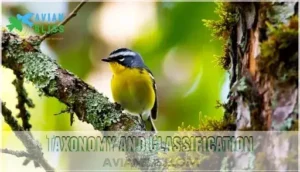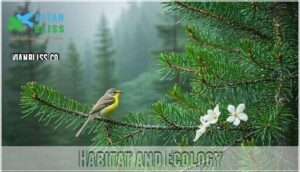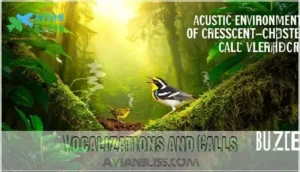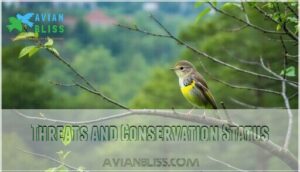This site is supported by our readers. We may earn a commission, at no cost to you, if you purchase through links.

This stunning songbird (Oreothlypis superciliosa) inhabits Mexico’s pine-oak forests at elevations between 1,500-3,000 meters, sporting a bold white eyebrow stripe above its blue-gray head.
Unlike long-distance migrants, this warbler simply moves downslope during winter months, staying within the same mountain systems year-round.
Males display deeper, more vibrant plumage colors than females, especially during breeding season.
Understanding this warbler’s unique elevational migration patterns reveals fascinating insights about mountain bird survival strategies.
Table Of Contents
- Key Takeaways
- Taxonomy and Classification
- Physical Characteristics and Appearance
- Range and Distribution
- Habitat and Ecology
- Migration Patterns
- Breeding Behavior
- Vocalizations and Calls
- Diet and Feeding Habits
- Threats and Conservation Status
- Cultural Significance and Folklore
- Frequently Asked Questions (FAQs)
- How long do crescent-chested warblers typically live?
- Do they exhibit any unique courtship displays?
- How fast can crescent-chested warblers fly?
- Are there any notable predators of this species?
- Do they form mixed-species flocks with other birds?
- How long do crescent chested warblers live?
- What predators threaten crescent chested warbler populations?
- How do crescent chested warblers build nests?
- When do crescent chested warblers lay eggs?
- How can birdwatchers identify crescent chested warblers?
- Conclusion
Key Takeaways
- You’ll spot this warbler by its distinctive rusty-orange chest crescent against bright yellow underparts, plus a bold white eyebrow stripe above its blue-gray head.
- You won’t find these birds making long migrations—they’re year-round residents of Mexico’s pine-oak forests who simply move downslope during winter months.
- You can locate them in montane forests between 1,500-3,000 meters elevation, where they serve as important ecosystem indicators and insect population controllers.
- You’ll need to support conservation efforts since habitat loss from deforestation threatens their specialized cloud forest environments despite their current "Least Concern" status.
Taxonomy and Classification
When you’re trying to understand the Crescent-chested Warbler, you’ll discover it belongs to a fascinating evolutionary story.
This striking songbird, scientifically known as Oreothlypis superciliosa, sits within the New World warbler family Parulidae—a group that’s undergone major reshuffling as genetic analysis and phylogenetic trees reveal surprising relationships.
The taxonomy places this species in order Passeriformes, with bird taxonomy classification showing it’s part of genus Oreothlypis.
Recent avian taxonomy research using DNA sequencing has clarified its position among warblers, moving it from previous classification systems that relied solely on physical traits.
Five recognized subspecies exist: mexicana, palliata, parva, sodalis, and superciliosa.
Each shows subtle variations that reflect their evolutionary history and geographic isolation.
The species name "superciliosa" literally means "eyebrowed," referring to its distinctive white supercilium—a key feature for species identification.
Understanding this warbler’s taxonomic position helps you appreciate how it fits into the broader tapestry of New World warbler evolution and diversity.
Physical Characteristics and Appearance
The crescent-chested warbler stands out as one of nature’s most distinctive small songbirds. Measuring approximately 4¼ inches long, this compact warbler displays remarkable plumage colors that make identification straightforward.
The bird’s most striking physical characteristics include its crescent-shaped chest patch in reddish-brown, contrasting brilliantly against bright yellow underparts and throat.
Key identifying features include:
- Eye markings featuring a bold white supercilium above blue-gray head coloring
- Olive-green back and plain gray wings without wing bars
- Subtle feather patterns with males showing deeper coloration than females
- Compact body size averaging 10-12 centimeters with 16-centimeter wingspan
The warbler’s beak shape remains typically insectivorous – thin and pointed for gleaning small prey. Males exhibit more vibrant chest crescents during breeding season, while females display fainter markings.
Unlike the Northern Parula, this species lacks wing bars and possesses that distinctive broad white eyebrow stripe, making field identification reliable for experienced birders.
Range and Distribution
Now you understand this remarkable warbler’s appearance, let’s explore where you’ll find these vibrant songbirds. The Crescent-chested Warbler’s Geographic Range spans from northern Mexico through Central America to Nicaragua, making it endemic to this mountainous corridor.
You’ll encounter them primarily in Elevation Zones between 1,500 and 3,000 meters above sea level. Their Range Distribution centers on:
- Sierra Madre Oriental and Sierra Madre del Sur in Mexico, where populations remain year-round
- Guatemalan volcanic belt and Chiapas Highlands, supporting fragmented but stable communities
These warblers show remarkable Territorial Boundaries, with highest concentrations in montane oakpine forests of Mexico and extending into Honduras during non-breeding periods. Unlike many North American warblers, their Migration Routes involve minimal movement—mostly short altitudinal shifts during harsh weather rather than long-distance travel.
Their Habitat Preferences directly influence distribution patterns, with populations becoming increasingly fragmented where forest corridors are disrupted. Bird migration patterns for this species remain relatively simple: they’re homebodies who’ve mastered living in Central America’s cloud-kissed mountains.
Habitat and Ecology
Within their montane habitats, Crescent-Chested Warblers occupy specialized niches in the forest ecosystem.
You’ll discover them flourishing in pine-oak forests, cloud forests, and open woodland areas between 1,200-3,000 meters elevation.
These birds aren’t homebodies—they descend to lower elevations during winter months, showcasing remarkable adaptability to seasonal changes.
Their ecological role extends beyond simple insect consumption.
As they forage through forest canopies, they help maintain biodiversity conservation by controlling pest populations and inadvertently dispersing seeds.
Forest ecology studies reveal these warblers serve as reliable indicators of ecosystem health—their population fluctuations mirror broader environmental changes.
Unfortunately, habitat loss poses increasing threats to their survival.
Deforestation and fragmentation disrupt their specialized requirements for dense, humid forests.
The environmental impact of human activities forces populations into smaller, isolated patches.
Climate change compounds these challenges, altering precipitation patterns essential for maintaining their preferred cloud forest environments.
Conservation efforts focus on protecting remaining montane forest corridors essential for their long-term survival.
Migration Patterns
Unlike typical warbler migration patterns, Crescent-chested Warblers aren’t long-distance travelers.
You’ll find these birds making seasonal movements within their montane range, primarily shifting between elevations rather than crossing continents.
Their migration routes involve altitude shifts from higher breeding areas to lower wintering grounds during colder months.
The Crescent-Chested Warblers’ behavior is also characterized by their insectivorous diet preferences.
Here’s what makes their habitat tracking unique:
- Elevational Migration: Birds move downslope in winter, seeking warmer microclimates
- Local Movements: Stay within the same mountain systems year-round
- Opportunistic Timing: Migration patterns respond to food availability and weather
- Vagrant Records: Rare individuals occasionally wander into Arizona and Texas
Bird migration research shows these warblers exemplify "resident" behavior compared to their highly migratory cousins.
Breeding Behavior
Following their year-round residence patterns, Crescent-chested Warblers exhibit fascinating breeding behavior that unfolds like clockwork in montane forests. Males establish territories through elaborate courtship displays, performing aerial maneuvers and song sequences that’d make Broadway jealous.
Territorial defense becomes fierce during breeding seasons, with males chasing intruders from preferred nesting sites. Nesting habits involve constructing cup-shaped structures from moss, grass, and pine needles, typically hidden in dense vegetation or rock crevices.
Females select locations that offer maximum protection from predators while maintaining access to foraging areas. The breeding process can be broken down into several key stages, as outlined below:
| Breeding Stage | Duration | Key Behaviors |
|---|---|---|
| Territory establishment | 2-3 weeks | Males sing, chase competitors |
| Mating rituals | 1-2 weeks | Courtship flights, nest-site showing |
| Egg laying | 3-5 days | Female lays 3-4 whitish eggs |
| Incubation | 12-14 days | Female broods, male provides food |
| Fledging success | 8-12 days | Both parents feed nestlings |
Understanding bird breeding habits is vital for appreciating the complex social dynamics of Crescent-chested Warblers. Parental care demonstrates remarkable cooperation, with both adults delivering insects every few minutes.
This intensive feeding guarantees high fledging success rates, preparing young birds for independent forest life.
Vocalizations and Calls
The Crescent-Chested Warbler’s acoustic repertoire reveals fascinating insights into bird communication. These songbirds produce distinctive chipping calls featuring repeated buzzy notes that echo through montane forests.
Their buzzy electric calls pierce mountain mist like nature’s own telegraph system
Their song structure consists of short, dry electric buzzes lasting 2-7.5 minutes, creating complex acoustic signals that serve multiple functions.
Call patterns demonstrate remarkable consistency, with high, short "tsic" sounds forming the foundation of their vocal vocabulary. Bird vocalizations include:
- Buzzing calls accompanied by melodious chirps and rattles
- Vocal duets between paired individuals during breeding season
- Counter-singing displays that establish territorial boundaries
- Strategic hiatus intervals that punctuate vocal exchanges
Vocal learning occurs through social interactions, with young warblers developing their repertoire by mimicking adult warbler songs. These vocalizations calls serve critical functions in mate attraction, territory defense, and flock coordination. The complexity of their acoustic communication system reflects sophisticated neural processing, making them excellent subjects for studying avian vocal behavior in montane ecosystems.
Diet and Feeding Habits
You’ll find this warbler’s diet consists primarily of insects, spiders, and small arthropods gleaned from foliage in the forest canopy.
Their acrobatic foraging techniques include jumping through twigs, picking prey from leaf undersides, and hanging upside down to access hidden insects.
Food Sources
These adaptable warblers maintain a diverse bird diet centered on insect prey.
These small songbirds showcase remarkable dietary flexibility, switching between insects and berries as seasons change
You’ll find them targeting caterpillars, beetles, and small arthropods gleaned from foliage at mid-canopy foraging height.
Their seasonal diet shifts substantially—insects dominate breeding months while fruit consumption increases during winter.
This diet variation reflects smart adaptation to food availability, ensuring survival across changing conditions.
As primarily insectivorous birds, they consume a variety of beetles and spiders.
| Food Category | Primary Items | Peak Season |
|---|---|---|
| Insects | Caterpillars, beetles, spiders | Spring-Summer |
| Fruits | Native berries, small fruits | Fall-Winter |
| Arthropods | Small invertebrates | Year-round |
| Larvae | Insect larvae, soft prey | Breeding season |
Foraging Behavior
These songbirds showcase remarkable Technique Diversity in their bird foraging strategies.
You’ll observe them performing acrobatic maneuvers—hanging upside-down and gleaning insects from leaf undersides with precision.
Their Prey Selection focuses primarily on small arthropods, beetles, and caterpillars.
Foraging Heights typically occur in middle and upper tree canopies.
During winter months, Flock Dynamics shift as they join mixed-species groups for enhanced feeding efficiency.
Seasonal Variation influences their bird feeding habits, adapting techniques based on insect availability and forest conditions.
They often exhibit insectivorous feeding strategies, essential for their survival.
Threats and Conservation Status
You’ll find that the Crescent-Chested Warbler faces mounting pressure from habitat loss as forests are cleared for agriculture and development throughout its Central American range.
While currently listed as Least Concern by the IUCN, localized population declines in fragmented forest areas signal the need for continued monitoring and habitat protection efforts.
Human Impact on Populations
While you’ve explored what these warblers eat, human activities increasingly threaten their survival.
Habitat Loss through deforestation has reduced suitable range by over 35% in key regions, while Urbanization eliminates nesting sites.
Climate Change disrupts breeding timing and food availability, forcing populations upslope at 38 meters per decade.
One can find solutions for habitat loss online.
Human Impact manifests through multiple pathways:
- Forest Fragmentation from roads and logging isolates populations
- Agricultural pesticides reduce invertebrate prey and cause reproductive declines
- Birdwatching Tourism disrupts nesting behaviors when unregulated
Population Fluctuations reflect these combined pressures, with edge effects increasing nest predation by 22% in fragmented forests.
Conservation Efforts and Initiatives
Despite mounting pressures, dedicated bird conservation initiatives offer hope for warbler populations.
Habitat preservation programs protect critical montane forests while reforestation projects restore degraded areas.
Community involvement strengthens conservation through citizen science and local stewardship programs.
The birdwatching’s economic benefits can further aid conservation.
- Ecotourism impact: Responsible birdwatching generates funding that directly supports protection efforts
Conservation initiatives focus on climate resilience strategies, ensuring warbler habitats can adapt to changing conditions.
Bird protection measures include establishing protected corridors and implementing sustainable forestry practices that benefit both wildlife and local communities.
Research and Studies
Research on Crescent-chested Warblers reveals fascinating insights into their survival strategies.
Genetic analysis confirms their placement within Oreothlypis, while population studies track density variations across montane habitats.
Behavioral research documents site fidelity and foraging patterns, informing habitat modeling efforts that predict climate impacts on future distributions.
| Research Focus | Key Findings | Conservation Impact |
|---|---|---|
| Genetic Diversity | Monotypic species confirmed | Guides breeding programs |
| Population Dynamics | 2-8 pairs per hectare density | Habitat protection priorities |
| Disease Prevalence | Parasitism studies ongoing | Health monitoring protocols |
These studies reveal population trends remain stable, though localized declines occur where deforestation fragments their cloud forest homes.
Cultural Significance and Folklore
While conservation efforts focus on protecting the Crescent-chested Warbler’s habitat, this species carries deeper cultural resonance throughout Central America.
Indigenous communities have woven this distinctive songbird into their spiritual fabric, creating rich traditions that span generations.
Local legends often portray the warbler’s melodic calls as messages from ancestral spirits. Bird mythology describes how hearing its song at dawn brings good fortune, while evening calls may warn of approaching challenges. These beliefs demonstrate the profound bird cultural significance within native traditions.
Indigenous lore has historically incorporated the warbler’s feathers into ceremonial healing practices, though such uses have declined with modern conservation awareness. The bird’s striking crescent marking appears frequently in artistic depictions across traditional textiles and pottery, showcasing remarkable attention to detail.
Today’s birdwatching culture continues honoring these traditions while promoting conservation. Consider these cultural connections:
- Symbolism varies by region – prosperity in Guatemala, wisdom in Honduras
- Bird folklore links the species to seasonal agricultural cycles
- Bird art features prominently in contemporary indigenous crafts
- Bird symbolism represents the connection between earth and sky domains.
These cultural threads illustrate how nature and human heritage intertwine beautifully.
Frequently Asked Questions (FAQs)
How long do crescent-chested warblers typically live?
You’ll find that lifespan data for these small montane warblers remains largely unstudied in scientific literature.
Most small warbler species typically live 3-7 years in wild conditions, though specific longevity records aren’t documented for this particular species.
Do they exhibit any unique courtship displays?
Male crescent-chested warblers perform elaborate displays during breeding season, showcasing their vibrant chest crescents through specific postures and movements.
You’ll observe territorial males defending nesting areas with distinctive vocal performances and visual demonstrations to attract potential mates effectively, which includes showcasing their vibrant chest crescents.
How fast can crescent-chested warblers fly?
You’ll find these compact warblers typically cruise at 15-25 mph during normal flight, though they can reach bursts of 35 mph when escaping predators or traversing through dense montane forests.
Are there any notable predators of this species?
Countless threats lurk in these montane forests, yet specific predator information isn’t well-documented for this species.
You’ll likely find hawks, eagles, and owls posing the greatest danger alongside ground-dwelling mammals that threaten nests.
Do they form mixed-species flocks with other birds?
Yes, you’ll often spot these warblers joining mixed-species flocks, especially during winter months. They team up with other insectivorous birds while foraging through the forest midstory and canopy layers.
How long do crescent chested warblers live?
Unfortunately, you won’t find specific lifespan data for these warblers in current research.
Most small songbirds like this species typically live 2-6 years in the wild, though detailed longevity studies remain limited for this particular mountain-dwelling warbler.
What predators threaten crescent chested warbler populations?
Don’t count your chickens before they hatch when evaluating threats to these populations.
You’ll find hawks, owls, snakes, and small mammals pose the greatest predation risks to crescent-chested warblers, particularly targeting eggs, nestlings, and fledglings during vulnerable breeding periods.
How do crescent chested warblers build nests?
You’ll gather materials systematically, weaving moss and grass together with conifer needles to create a sturdy foundation.
The female builds the nest without male assistance, using fine materials to line it.
When do crescent chested warblers lay eggs?
While timing varies by latitude, you’ll typically find these warblers laying eggs during their breeding season from April through June.
With peak activity in May when insect abundance supports successful reproduction.
How can birdwatchers identify crescent chested warblers?
Look for the distinctive reddish-brown crescent across the bright yellow chest, paired with a blue-gray head featuring a bold white eyebrow.
You’ll spot them in montane oak-pine forests, often foraging in mixed flocks within the forest canopy.
Conclusion
Imagine watching a mountain researcher track the same crescent-chested warbler from pine canopy to oak understory as seasons change—no passport required for this remarkable journey.
Understanding the crescent chested warbler’s elevational migration reveals nature’s elegant solution to harsh mountain winters.
You’ve discovered how this stunning songbird navigates Mexico’s vertical landscapes, maintaining year-round residence through simple downslope movements.
Their rusty-orange chest crescents serve as perfect identification markers during your mountain birding adventures.
Conservation efforts protecting pine-oak forests guarantee future generations can witness these remarkable elevational migrants.













